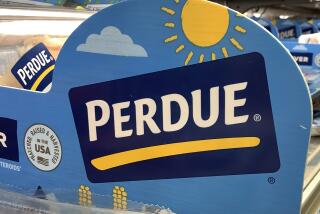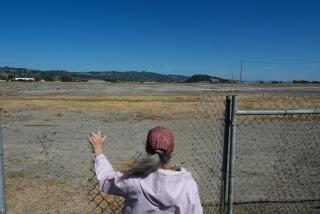Hunt Launched for Fence Parts Found to Be Radioactive
- Share via
The Nuclear Regulatory Commission has launched a nationwide search for steel fence parts that were found to be slightly radioactive when a truckload of them set off radiation monitors at a nuclear weapons plant in Washington state.
Manufactured by the Katia Steel Rolling Works in Calcutta, India, the fence parts are contaminated with cobalt-60, but the levels are considered too low to be a threat to animals or people, NRC spokesman Gregory Cook said Thursday.
“It (cobalt-60) appears to be right in the steel itself,” Cook said in a telephone interview from regional NRC headquarters in Walnut Creek. “What we do know is that we have found nothing at a level that would present any kind of credible safety hazard.” Cobalt-60, a radioactive isotope, is used in industry and medical equipment.
Upward of several thousand of the parts--known as tension bars--are believed to have been distributed to hardware stores and other outlets throughout the United States. In California, some of the radioactive bars have been located in Hayward, Fresno, Sacramento and Fontana.
Cook said someone standing near a contaminated bar for eight hours a day throughout an entire year would absorb less than 1 millirem. By comparison, the average person is exposed to 300 millirems a year from natural background radiation. A rem is a measure of biological damage caused by ionization in human tissue. A millirem is one-thousandth of a rem. Despite the low levels, the NRC said it is tracking down the bars as a precaution. The materials may have been distributed by at least seven companies and scores of their subsidiaries across the country.
Although distributors are being asked to return their unsold bars, the NRC said it is not necessary for retailers or individuals who have built fences to return the material.
The radioactive bars were discovered last Monday when a fencing contractor exited the U.S. Department of Energy’s nuclear weapons plant at Hanford, Wash., and alarms sounded on hand-held radiation detectors. Individuals and vehicles leaving the sprawling weapons complex are routinely checked to deter the theft or accidental removal of radioactive material.
Cook said the contractor obtained the radioactive tension bars from Master-Halco Inc. in Portland. Company headquarters are in La Habra.
Managers at Master-Halco in La Habra said they have stopped all sales of the material.
“These materials will be kept away from our employees and customers until proper inspection and disposition can be made,” the company said in a prepared statement.
The firm purchased the bars in April from a small Riverside County importer identified by Cook as Transmark Sales. The material was unloaded from a ship at Portland.
Cook said Master-Halco brought in several pallets of the product, each containing an estimated 800 bars. One in five of the unsold bars tested by the NRC and Oregon officials proved to be radioactive.
In addition to Master-Halco, Cook said, six other distributors also may have sold the cargo throughout the country.
Tension bars are typically threaded through a chain- link fence to keep it taut and straight. The bars are three-sixteenths of an inch thick, five-eighths of an inch wide, and vary from 34 inches to 70 inches in length.
Just how the bars became radioactive is a matter of speculation. Cook said the Calcutta foundry that manufactured them obtained steel from three Indian steel mills, any one of which could have been the source of the radioactive cobalt-60. The steel mills use scrap metal--which may have been tainted--to produce steel.
“We are trying to determine what other products the (Katia) mill makes and who they may have gone to,” Cook said.
More to Read
Sign up for Essential California
The most important California stories and recommendations in your inbox every morning.
You may occasionally receive promotional content from the Los Angeles Times.













